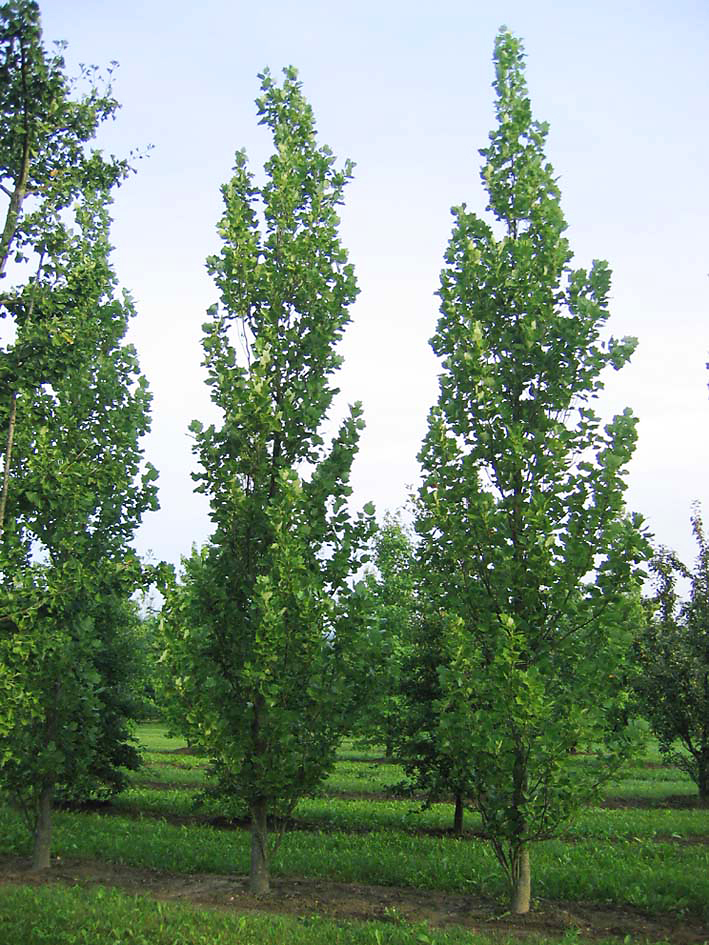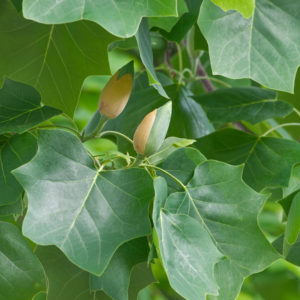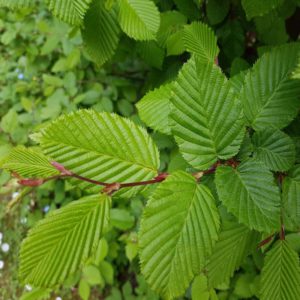Liriodendron tulipifera Fastigiata
€350.00
Frequently Bought Together


Description
Quick Facts
- Common Name: Fastigiate Tulip Tree, Upright Tulip Tree, Columnar Tulip Tree
- Botanical Name: Liriodendron tulipifera ‘Fastigiata’
- Plant Type: Deciduous tree
- Mature Height: 15-20m
- Mature Spread: 4-6m
- Flowering Period: June to July
- Flower Colour: Greenish-yellow with orange markings, tulip-shaped
- Foliage: Distinctive four-lobed leaves, bright green turning golden-yellow in autumn
- Hardiness: RHS H6 (hardy)
- Soil Requirements: Moist, well-drained, slightly acidic to neutral
- Aspect: Full sun to partial shade
- Maintenance: Low
Description
Discover the architectural magnificence of Liriodendron tulipifera ‘Fastigiata’, an exceptional columnar tree that brings dramatic vertical presence, unique foliage, and spectacular flowers to gardens where space is limited but impact is essential. This outstanding cultivar offers exceptional beauty in a space-saving form—a naturally narrow, upright habit that reaches impressive heights without spreading width, distinctive saddle-shaped leaves that are unlike any other tree, spectacular tulip-like flowers in summer that give this tree its common name, and brilliant golden-yellow autumn colour that creates a stunning finale to the growing season, making this one of the most architecturally striking trees for contemporary landscapes.
Throughout spring and summer, this captivating tree displays its characteristic four-lobed leaves of bright green, each measuring 10-15cm across with a distinctive squared-off or notched apex that creates an instantly recognizable silhouette. The unusual leaf shape—often described as resembling a cat’s face or saddle—provides exceptional textural interest and architectural presence. In early to midsummer, mature trees produce spectacular tulip-shaped flowers measuring 5-6cm across, with greenish-yellow petals marked with orange at the base, creating exotic blooms that sit upright on the branches like elegant chalices. The naturally columnar form develops a strong central leader with upward-sweeping branches, creating a narrow, elegant silhouette perfect for confined spaces. As autumn arrives, the entire canopy transforms into brilliant shades of golden-yellow, creating spectacular seasonal drama.
Native to eastern North America, the species Liriodendron tulipifera is one of the tallest and most magnificent hardwood trees, reaching over 50m in its native habitat. The ‘Fastigiata’ cultivar was selected for its exceptional narrow, upright form, making the beauty and unique characteristics of the Tulip Tree accessible to gardens with limited space. The name ‘Liriodendron’ means ‘lily tree’ in Greek, whilst ‘tulipifera’ means ‘tulip-bearing’. Hardy and adaptable, this tree thrives in Irish conditions, preferring deep, moisture-retentive soils and sheltered positions for best growth.
Create stunning compositions by planting as dramatic vertical accents in mixed borders, contemporary landscapes, or formal gardens where the columnar form creates architectural emphasis. Magnificent in avenue plantings for narrow spaces, in pairs flanking entrances or pathways, or as specimen trees in smaller gardens where spreading trees would overwhelm. Works beautifully combined with lower-growing shrubs and perennials that won’t compete with the vertical form, or in groups of three for dramatic impact in larger settings.
Caragh Garden Notebook
Planting: Space trees 5-6m apart for avenue plantings, or allow 6-8m for specimen placement. Plant container-grown specimens year-round, though spring or early autumn is ideal. Dig holes twice the width of the root ball and incorporate generous amounts of organic matter. Plant at the same depth as the container. Stake securely for the first 3-4 years to support the tall, narrow form. Water thoroughly and mulch generously around the base. Choose sheltered positions protected from strong winds.
Soil Preparation: Thrives in deep, moist, well-drained soil with pH 5.5-7.0. Prefers slightly acidic to neutral, fertile conditions enriched with generous amounts of organic matter. Dislikes shallow, chalky, or waterlogged soils. Requires deep soil for the extensive root system. Incorporate well-rotted compost or manure to improve soil structure and moisture retention. Best growth occurs in full sun with consistent moisture and shelter from strong winds. Avoid exposed sites.
Container Growing: Not suitable for long-term container growing due to size, vigorous growth, and extensive root system. Young specimens can be grown temporarily in very large containers (minimum 80cm diameter) using soil-based compost, but should be planted out within 2-3 years for best long-term health and to achieve full height potential, flowering capability, and spectacular autumn colour.
Seasonal Care: Requires minimal pruning—the naturally columnar form develops without intervention. Remove only dead or damaged branches in late winter when dormant. Avoid heavy pruning which can spoil the natural fastigiate habit. Remove any branches that grow outward at wide angles to maintain the narrow, upright form if desired. Apply slow-release balanced fertiliser in early spring. Mulch generously with organic matter to retain moisture—consistent moisture is essential for best growth. Water during dry spells, especially in the first 3-5 years until well established.
Propagation: Propagate by grafting scions onto Liriodendron tulipifera rootstock in late winter (specialist technique requiring expertise). The fastigiate form cannot be reliably reproduced from cuttings. Seed-grown plants will not come true to type and will produce spreading forms typical of the species, not the narrow columnar habit. Most gardeners prefer to purchase nursery-grown grafted specimens for guaranteed quality and true-to-type fastigiate form.
This architectural beauty is absolutely stunning—that narrow, columnar form combined with those unique saddle-shaped leaves creates incredible vertical drama! The tulip-shaped flowers in summer are exotic and beautiful, and that golden-yellow autumn colour is simply spectacular. Perfect for bringing the magnificence of the Tulip Tree to smaller Irish gardens where space is precious. A true statement tree!






